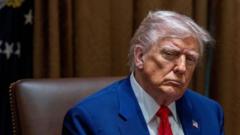1) Negotiating Better Trade Agreements
Trump claimed that years of unfair trade practices have led to the U.S. being exploited. Initially, his proposal involved a sweeping tariff on all imports. Surprisingly, the recent 90-day pause in tariff increases has catalyzed negotiations with nations like South Korea and Japan, indicating some potential for meeting Trump’s ambitious goal of securing better trade deals.
2) Revitalizing American Industry
Trump has long believed that tariffs would invigorate manufacturing in the U.S. However, the inconsistent nature of his tariff approach has created instability, leading businesses to hesitate on expanding or relocating their operations domestically.
3) Confronting China
Trump's sharp pivot towards targeting China underscores his fierce stance against perceived unfair practices. However, while his administration acknowledges the challenges posed by China, the undertaking presents risks of escalating tensions, potentially straining vital alliances in the process.
4) Generating Revenue
Trump's tariff plans highlighted possible revenue that, according to estimates, could amount to $2 trillion over the next decade. Achieving this revenue hinges on maintaining current tariff structures, although shifts towards domestic production risk diminishing income from tariffs.
5) Reducing Consumer Prices
Despite Trump's assertions that tariffs may lead to lower consumer prices through increased domestic competition, experts caution that such policies could instead inflate costs. Projections suggest that households might incur an average increase of over $1,000 annually due to these tariffs, raising serious concerns for low-income families.
In conclusion, while Trump's tariff pursuits reflect a bold reshaping of trade policy, the realization of these goals is far from certain, with various economic indicators and alliances at play. The balancing act continues as his administration navigates these complex trade waters.
Trump claimed that years of unfair trade practices have led to the U.S. being exploited. Initially, his proposal involved a sweeping tariff on all imports. Surprisingly, the recent 90-day pause in tariff increases has catalyzed negotiations with nations like South Korea and Japan, indicating some potential for meeting Trump’s ambitious goal of securing better trade deals.
2) Revitalizing American Industry
Trump has long believed that tariffs would invigorate manufacturing in the U.S. However, the inconsistent nature of his tariff approach has created instability, leading businesses to hesitate on expanding or relocating their operations domestically.
3) Confronting China
Trump's sharp pivot towards targeting China underscores his fierce stance against perceived unfair practices. However, while his administration acknowledges the challenges posed by China, the undertaking presents risks of escalating tensions, potentially straining vital alliances in the process.
4) Generating Revenue
Trump's tariff plans highlighted possible revenue that, according to estimates, could amount to $2 trillion over the next decade. Achieving this revenue hinges on maintaining current tariff structures, although shifts towards domestic production risk diminishing income from tariffs.
5) Reducing Consumer Prices
Despite Trump's assertions that tariffs may lead to lower consumer prices through increased domestic competition, experts caution that such policies could instead inflate costs. Projections suggest that households might incur an average increase of over $1,000 annually due to these tariffs, raising serious concerns for low-income families.
In conclusion, while Trump's tariff pursuits reflect a bold reshaping of trade policy, the realization of these goals is far from certain, with various economic indicators and alliances at play. The balancing act continues as his administration navigates these complex trade waters.





















